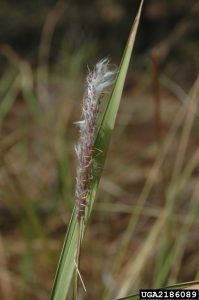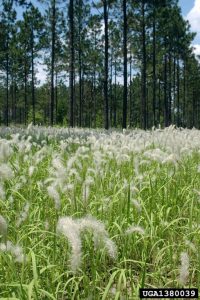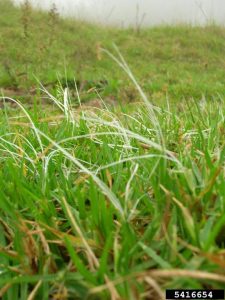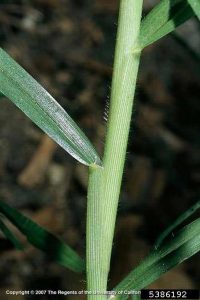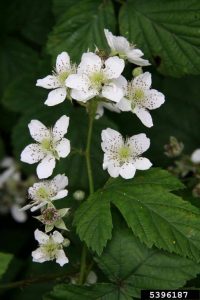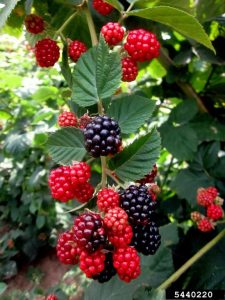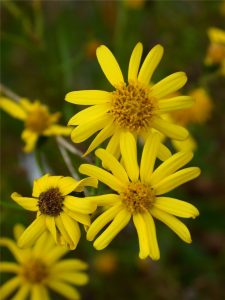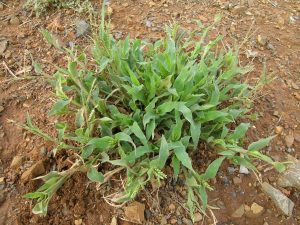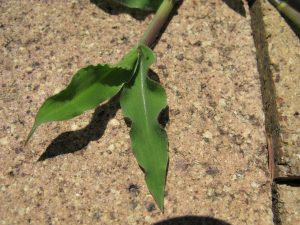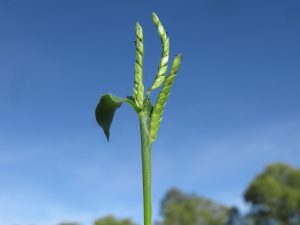Heracleum mantegazzianum, giant hogweed
General Description
Giant hogweed gets its name due to its large size growing up to 5 meters (16.4 feet) tall. It is a biennial or perennial plant that can cause photosensitivity when touched. The plants may die after flowering or flower for several years. Giant hogweed is native to the Southwestern Asia and the Caucasus Mountains. The introduced range of giant hogweed includes central Russia and Europe, Australia, New Zealand, Canada, and the U.S.. At the time of this writing, giant hogweed is known in Kake, Alaska, and is the only known Federal Noxious Weed to be in Alaska.
Identification
Giant hogweed typically grows to 3 meters (9.8 feet) and up to 5 meters (16.4 feet) in height (Figure 1). The stems are 5-10 cm (2-4 inches) in diameter, are hollow, have reddish-purple spots, and are covered in bristles (Figure 2). Leaves are compound, deeply dissected, and relatively large with a width of 91-152 cm (36-60 inches) (Figure 3). Leaf size though can vary with maturity and has been observed smaller. The inflorescence is shaped in an umbel composed of many small white to light pink flowers that together can be up to 76 cm (30 inches) in diameter (Figure 1).

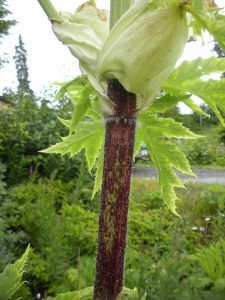
Giant hogweed looks similar to the native cow parsnip (Heracleum maximum), but cow carsnip has palmately lobed leaves instead of deeply dissected leaves, and is generally smaller all around with leaves, flower umbels, and overall height less than half of that of giant hogweed.
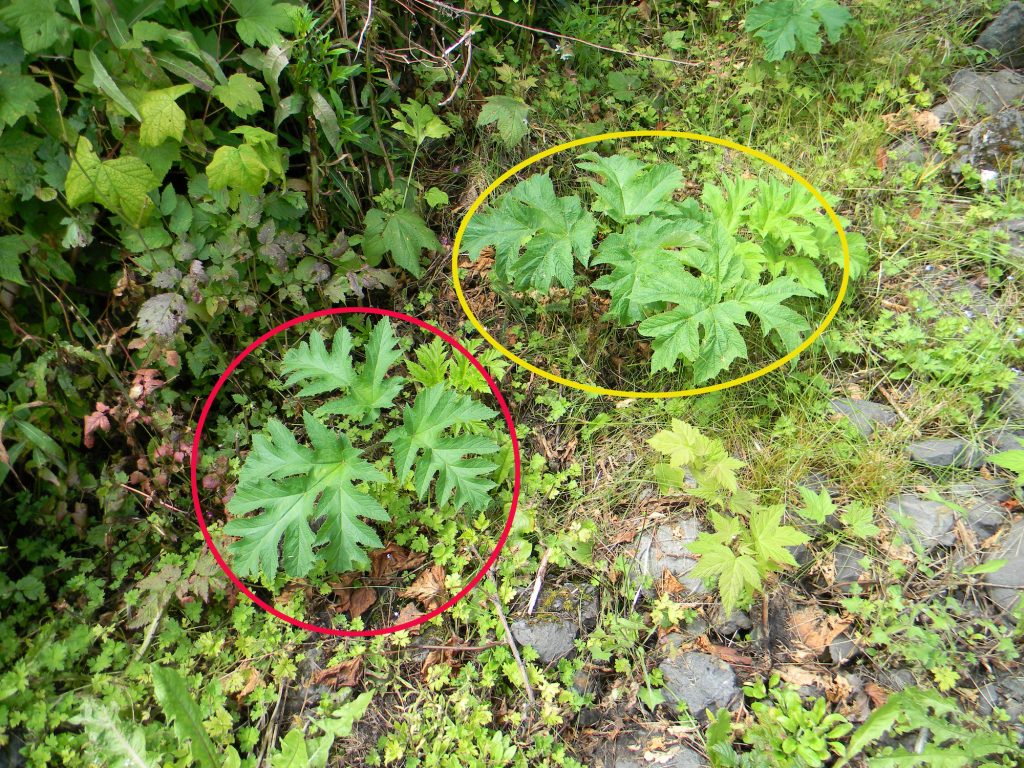
Additional visual information on the identification of giant hogweed can be found in the following videos:
Impact and spread
Giant hogweed produces a sap which causes sever dermatitis if touched by humans or animals. Hogweed creates a new canopy layer that may outcompete native vegetation. The number of seeds can be up to 50,000, and remain viable in the soil for more than 7 years. While the seeds can be wind dispersed short distances they usually drop near the plant. Giant hogweed is spread as an ornamental escapee. Although it isn’t legal to sell giant hogweed in the United States it is sometimes misidentified and sold as a similar plant.
Management
Giant hogweed may be controlled mechanically by removing the entire root system, simply cutting the plants is ineffective. Herbicides can be effective on giant hogweed. Due to the seed bank a long term management and monitoring program will be necessary.
Where to look
Giant hogweed grows in sandy and silty areas, and tolerates soils saturated with water. However, hogweed will grow on driers sites. Hogweed is known in Kake, Alaska, and climate matching indicates that it may grow in most other parts of Alaska including the interior portions of the state. Likely you will find hogweed growing as an escaped ornamental.
Other resources:
- http://accs.uaa.alaska.edu/files/invasive-species/Heracleum_mantegazzianum_BIO_HEMA17.pdf
- https://www.invasivespeciesinfo.gov/plants/hogweed.shtl
- https://www.na.fs.fed.us/fhp/invasive_plants/weeds/giant-hogweed.pdf
Imperata cylindrica, cogongrass
(this is a very southern US species that has been found occasionally in northern states)
General Description
Cogongrass is native to Asia, and was first introduced to North America as packaging material. Cogongrass was planted in North America for forage and erosion control. While cogongrass is a problem in a handful of Southern States, there are also infestations reported as far north as Oregon putting other Northern States on the lookout.
Identification
Cogongrass is a perennial grass that spreads with rhizomes and seed. Cogongrass grows 60-122 centimeters (2-4 feet) tall, and has 2.5 centimeters (1 inch) wide leaves with a white midrib (Figure 5), and a sharp point at the end of the leaf blade (Figure 6). Lower surface of leaves may be hairy at the base, but not at the distal portions. Flowers are arranged in 3-11 inch panicles that are silvery (Figure 7). Good videos on the identification of cogongrass are found at https://www.invasivespeciesinfo.gov/plants/cogongrass.shtml.
Impact and spread
Cogongrass spreads by seed and rhizomes. Seeds may be spread by wind, and a single plant may produce up to 3000 seeds per head. Rhizomes may remain dormant for extended periods of time which aids their spread.
Cogongrass invades disturbed areas forming dense layer of thatch that is difficult for other plants to grow in. Some ground nesting species may be displaced by the thatch and otherwise dense cover of cogongrass. The dense cover of cogongrass alters the fire regime in large infested areas, and it is well adapted to fire. Serrated leaves make cogongrass unpalatable to most grazing animals.
Management
Mowing and burning will stimulate growth and spread, however tilling multiple times will remove cogongrass. Herbicides are effective for management, particularly in natural areas where tilling isn’t possible.
Where to look
Cogongrass is primarily a species of the Southern United States, but is occasionally seen as a new invader in Northern States. Cogongrass is tolerant of a variety of conditions including shade, drought, high moisture, and salinity. Cogongrass has invaded coastal areas, natural forests, grasslands, riparian areas, urban areas, and wetlands. Climate comparisons indicate that Cogongrass is most suitable to Southeast Alaska.
Other resources:
- https://www.invasivespeciesinfo.gov/plants/cogongrass.shtml
- https://www.na.fs.fed.us/fhp/invasive_plants/weeds/cogongrass.pdf
- https://www.nrcs.usda.gov/Internet/FSE_DOCUMENTS/nrcs141p2_021449.pdf
Pennisetum clandestinum, Kikuyugrass
General Description
Kikuyugrass is a perennial grass native to Eastern Africa, and introduced to California. Climates in Alaska suitable to kikuyugrass include Southeast Alaska, but it isn’t likely to establish in other parts of Alaska. In the introduced range of kikuyugrass it is found in disturbed areas and roadsides.
Identification
Kikuyugrass is a prostrate grass with light green leaves that are 2.5-25.4 centimeters (1-10 inches) long (Figure 8 and 9). Leaves have flat blades 3-6.4 millimeters (1/8 to ¼ inch) wide and pointed tips. Leaves and stems of kikuyugrass are hairy , and at the leaf collar hairs form a long fringe that parallel the stem(Figure 10).
Impact and spread
Documented impacts revolve around turfgrass, ornamental plantings, and orchards in California. In turfgrass it provides an undesirable texture, and forms mats that can make golf and other sport activities difficult. In ornamental plantings it is a general weed that competes with ground covers, and other plants. In orchards it competes for nutrients, water, and can cause issues for irrigation systems by blocking flow from sprinklers and drainage ditches.
Kikuyugrass spreads easily on equipment by seed or plant parts because cut plants can regenerate easily by rooting at nodes. It spreads naturally through seed, and vegetatively as it’s prostrate growth aids it’s ability to root at nodes of stems.
Management
Prevention is key to management of kikuyugrass. Any soil or equipment coming from infested areas (California) should be inspected to ensure they are free of kikuyugrass, and equipment should be clean of all soil and vegetation. If kikuyugrass is introduced, it can be controlled by hand pulling, covering or herbicides depending on the area that it is growing in. In an ornamental planting spot spraying or covering will work best on infestations that can’t be pulled. If in turf grass applications of herbicides containing triclopyr can provide selective control. Spot spraying with glyphosate may also be effective, but may damage desirable grasses. Total renovation of a lawn may be necessary and covering with weed barrier fabric for an extended period of time may be an alternative to herbicides. In unmanaged landscapes kikuyugrass is usually found where water is readily available, which in Southeast Alaska may be most anywhere. If manual control is not feasible, glyphosate and residual herbicides may provide the best control options.
Where to look
Look for kikuyugrass in waste areas that are wet, in ornamental plantings or lawns. Kikuyugrass isn’t likely to be deliberately introduced as an ornamental, however it may be introduced as a contaminant of ornamental products. Suitable climates for kikiyugrass occur in Southeast Alaska.
Other resources:
- http://ipm.ucanr.edu/PMG/PESTNOTES/pn7458.html
- https://plants.usda.gov/core/profile?symbol=PECL2
- http://www.cal-ipc.org/ip/management/plant_profiles/Pennisetum_clandestinum.php
Rubus fruticosus, Wild blackberry complex
General Description
Wild blackberry are native to Europe and Asia. Where blackberry are invasive they were deliberately introduced for fruit production and to form hedges that form a living barrier to people and animal movement. In Australia where the plant is known to be invasive blackberry are still grown as a fruit crop.
Identification
Blackberry have a perennial root system with biennial canes, that form a tangled woody shrub. The canes grow up to 2 meters (6.5 feet) or more tall and have prickly generally backward pointing thorns (Figure 11). The leaf shape and plant form can be variable. Canes vary in color including green, purplish, or red, they may be round or angled. Leaves are alternate and divided into 3-5 serrated, stalked oval, palmate leaflets that are dark green on top and pale beneath. Flowers form clusters, and individual flowers are 2-3 cm (3/4-1 inch) wide, white to pink, with five petals (Figure 12). Fruits are a berry similar to raspberry or salmonberry, only the color changes from green to red to black (Figure 13).
Impact and spread
Blackberry are highly invasive where introduced. They can grow aggressively leaving a shade and organic layer that excludes other vegetation. Blackberry forms dense thickets with sprawling canes that can root at the tips. Roots also spread with rhizomes. The seed are spread by animals that feed on the fruit primarily birds, but also small mammals. The thorns combined with the sprawling growth habit can form impenetrable thickets.
Management
Manual control involves cutting the canes, followed by hand digging or plowing the root crowns. However, blackberry will regrow from any root or stem fragment making manual control unlikely to eradicate the species from an infested area. Many herbicides are known to be effective, however applications may be complicated for larger infestations because of the difficulty to access inner portions of the thicket.
Where to look
In places with introduced blackberry they were introduced to form hedge rows, and as a fruit crop. Look for blackberry growing along fences, roads, as an ornamental, or as a contaminant in ornamental plantings. Once escaped, blackberry may grow in wasteland, steep banks, forest clearings, wetlands, riparian areas, and open meadows or pastures. Climates in Alaska suitable for blackberry are in Southeast and Southcentral Alaska.
Other resources:
- http://www.cabi.org/isc/datasheet/47995
- https://www.invasive.org/browse/subinfo.cfm?sub=4573
- https://www.environment.gov.au/biodiversity/invasive/weeds/publications/guidelines/wons/pubs/r-fruticosus.pdf
- http://accs.uaa.alaska.edu/files/invasive-species/Rubus_discolor_BIO_RUDI2.pdf
Senecio inaequidens, South African ragwort
General Description
South African ragwort is native to areas of South Africa between elevations of approximately 1000 and 3000 meters (3280-9840 feet) growing in grasslands and savannah. In the introduced range of South African ragwort it is often found at high elevation in mountains. It invaded central and Northern Europe as a contaminant of sheep wool. Since introduction South African ragwort has spread along human disturbance lines such as roads and railways.
Identification
South African ragwort is a perennial herb that is woody at its base and has highly branched stems reaching approximately 60 cm (2 feet) in height (Figure 14). Leaves are narrow, 1-7 mm (1/20-3/4 inches) wide, and linear, but can be highly variable (Figure 15). Flowers are yellow about 25 mm (1 inch) in diameter, and there are numerous flowers per plant (Figure 16).
Impact and spread
South African ragwort spreads by seed, and in North and Central Europe where it is has a long history of introduction it has spread along roads and railways. The species is expected to spread to grasslands and pastures, and has become a serious weed of vineyards. South African ragwort is toxic, and has potential to spread to arable lands making it a significant threat to agricultural production and potentially natural areas.
Management
Natural area management of light infestations can be successful with repeated hand pulling for several years. South African ragwort is reportedly less susceptible to herbicides once mature.
Where to look
Where South African ragwort is introduced it is typically found in disturbed habitats, and may also invade rocky or sandy areas. In its’ native range South African ragwort is also found in areas damaged by fire, and various habitats including both wet and dry, full and partial sun exposure, and various soil types. As a newly introduced species it is likely to be present in disturbed sites such as roadsides, railways, and associated pullouts. Suitable climates for South African ragwort exist in Southeast Alaska.
Other resources:
- https://www.nobanis.org/globalassets/speciesinfo/s/senecio-inaequidens/senecio_inaequidens.pdf
- http://www.iucngisd.org/gisd/species.php?sc=1458
- http://www.plantwise.org/KnowledgeBank/Datasheet.aspx?dsid=49557
- http://www.cabi.org/isc/datasheet/49557
Urochloa panicoides, Liverseed grass
General Description
Liverseed grass is native to Africa and common in heavily grazed areas. However, in India, where it is also native it is present in ungrazed areas, and is reduced by grazing. Liverseed grass is a concern for introduction as a contaminant of cereal seed.
Identification
Liverseed grass is an annual tufted grass between 6 and 60 cm (2.4-24 inches) tall, however sometimes is laying down (Figure 17). Lower nodes of the grass can root when in contact with the soil. Leaves are hairy, and up to 12 mm (1/2 inches) wide with light green margins that are crinkled (Figure 18). Ligules of the leaves have hairs that are 1mm long. The inflorescence (flower head) is 8 cm (3 inches) long and cylindrical, and composed of many small flowers that form two regular rows (Figure 19).
Impact and spread
Introduced to the U.S. and Australia, liverseed grass is a concern when it invades pastures and crops. Liverseed grass is poisonous to cattle, and once established is difficult to eradicate.
Management
In cultivated fields, plowing during the most favorable growing period of Liverseed grass can reduce it’s numbers. Small infestations could be hand pulled. Chemical control may be effective; however, use of herbicides with residual properties to control late germinating seedlings may be necessary.
Where to look
Liverseed grass is mostly likely to arrive to Alaska as a contaminant of cereal grains used for feed or planting. It may not persist in many of the areas where cereal grains are planted in Alaska, but should be reported if found so a determination can be made on need for eradication and what the source of the infestation was. If Liverseed grass persists in Alaska after introduction it is likely to be found in shady or damp areas. Suitable habitats for liverseed grass in Alaska are located on Kodiak Island, the Alaska and Kenai Peninsulas.



